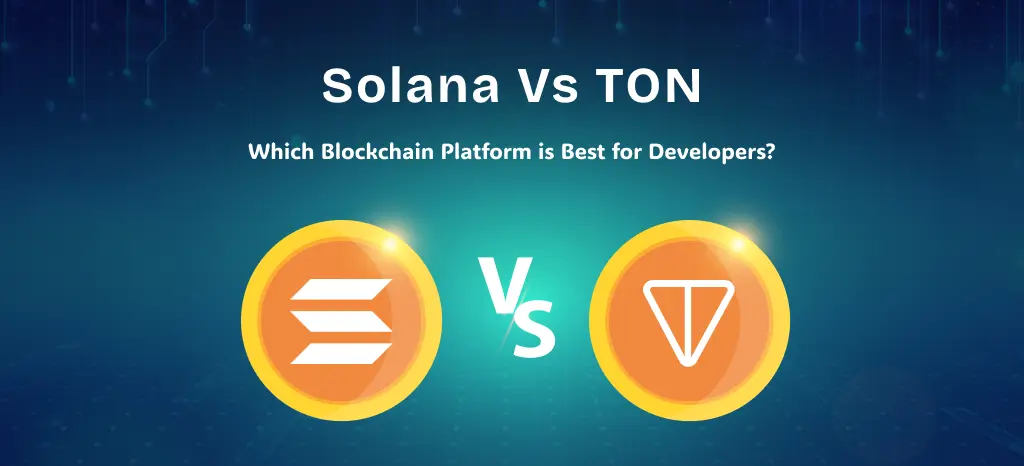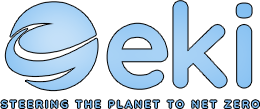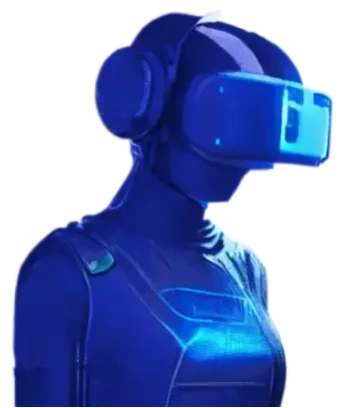
As the world of blockchain moves fast, choosing the right platform to build decentralized applications (dApps) is a significant decision for developers. When it comes to high-performance, scalable, and secure blockchain networks, two competitors appear on the stage: Solana and The Open Network (TON). They are both innovations that offer new features or abilities, thus attractive opportunities for developers. However, before selecting an appropriate platform to suit a certain program, one must weigh the advantages and drawbacks of each of them.
This blog provides a detailed and comprehensive analysis of Solana over the TON Chain and vice versa, with a strong focus on technical architecture, ecosystem readiness, developer community, and universality of the two blockchains. At the end of this analysis, the developers will be better able to distinguish which platform is most appropriate based on the requirements and objectives.
What is Solana?
Solana is one of the highly efficient blockchains at this moment that has gained a lot of attention, mainly because of its high performance and high speed. Introduced in 2020, Solana was designed to become a reaction to the scalability problems that numerous current blockchain networks—including Ethereum—own. Its core strength lies in employing Proof of Stake (PoS) alongside a unique consensus algorithm known as Proof of History (PoH).
Solana's Key Features
-
High Throughput: Solana is among the high-performance blockchains recognized in the current world, processing more than 65,000 transactions per second. While PoH puts timestamps to transactions, PoS verifies them, and together they allow such a high throughput.
-
Low Latency: This network architecture makes the transactions verified within a short time, thus making low latency. DEXs and gaming would benefit from this since most of the applications that use real-time communication are seen in these categories.
-
Low Transaction Costs: With high network activity, Solana enables one to transact at low fees because of its scalability. This means that developers put up dApps with frequent minor transactions and will indeed find this appealing.
-
Ecosystem Growth: It is based on the Solana ecosystem that multi-dApps, DeFi projects, NFTs, and more inventions have emerged in a short time. The Solana Foundation doesn’t cease to support creators through funding in Solana, hackathons, and tutorials.
What is a TON Network?
A layer-1 blockchain developed by the developers of the popular messaging app Telegram is The Open Network (TON), designed to process millions of transactions per second fast and securely while being, at the same time, decentralized. Originally developed by Telegram developers, TON has evolved into a community-driven decentralized platform with a focus on scalability and interoperability.
TON’s Key Features
-
Massive Scalability: Thus, the general architecture of TON provides for sharding and simultaneous processing of transactions in several chains, as well as load distribution in real time. As such, it is quite beneficial for cases where multiple visitors will be accessing the website on a particular day.
-
Fast Transactions: It is basically fast; block generation time has been pegged at less than a second. This makes sure that each transaction is confirmed as nearly instantaneous as possible to give the users a good experience.
-
Decentralization and Security: TON remains fully decentralized and does not sacrifice any aspects of decentralization on the altar of high speed and scalability. Despite its centralized approach, its consensus mechanism is formulated in a way that makes the network safe for use and free from invaders.
-
Interoperability: Designed to be compatible with other blockchains, TON is made easy to incorporate into cross-chain applications and different digital assets for developers.
-
Telegram Integration: One more advantage is the integration of TON into the Telegram environment, thus giving access to users at a global level. Its infrastructure can be used by developers to attract users’ investment and their focus, and it becomes easier to fund their projects.
Comparison: Solana vs. TON
-
Consensus Mechanisms:
Solana: Without the need for extensive communication, nodes may agree on the chronological order of events on the blockchain due to its Proof of History (PoH) being a cryptographic clock. Due to this, transaction processing regimens are sped up appreciably, and web traffic declines. The PoS method protects the network in the sense of making sure that validators are incentivized to act honestly.
TON: To make it more scalable, it uses load balancing, sharding, and the Proof of Stake (PoS) consensus algorithm similar to Solana. Each shard is self-sufficient as it processes transactions and smart contracts; at the same time, all shards are synchronized to maintain the overall connection and system security of the network.
2. Scalability:
Solana: Solana’s architecture focuses on horizontal scalability and is developed for high throughput. The platform is ideal for use with high-frequency trading services, decentralized applications about finance, and also games; this is because it can formulate numerous dealings without slowing down.
TON: With sharding technology, TON can scale horizontally, potentially supporting millions of transactions per second. This makes it a right fit for applications that need vast expansion and are bulky, for instance, gigantic gaming worlds, social networks, and international payment systems.
3. Transaction Speed and Latency:
Solana: It offers post-low latency because of the high TPS and has very small block times of below one second. This generates an idea for apps such as DEX’s real-time financial application and wherever speed and dependability count.
TON: With its sensible consensus mechanism and network design, it also supports high & low-latency transactions. The platform is ideal for applications, designed to guarantee near-instantaneous confirmations.
4. Developer Experience and Tools:
Solana: When it comes to the facilities for dApps development and the ways to test them, the Solana environment provides developers with the Solana SDK, Solana Playground, and numerous APIs. Other popular languages like Rust and C are also supported by the platform, allowing a myriad of developers to harness the platform. Solana places a lot of emphasis on onboarding new developers, and due to that, there is a lot of documentation and tutorials on Solana.
TON: TON provides developers with a solid toolkit of development: TON SDK, TON OS (the system that allows one to interact with the blockchain), and TON Labsa, to which one can turn for a range of services. Through TON Studio, smart contracts are developed using TON Solidity and Fift, a TON-specific programming language. In comparison to Solana, TON has significantly less development community, but it is rapidly growing due to more tools and support given to developers.
Use Cases: TON vs. Solana
Solana Use Cases:
-
DeFi Applications: In DeFi applications such as lending platforms, decentralized exchanges, and stablecoins, Solana, with its capability to process thousands of transactions per second and low latency, is desirable.
-
NFT Marketplaces: Solana is currently trending for NFT markets, enabling users to mint and trade NFTs at very low fees and within a short timeframe.
-
Gaming: Solana works well with gaming platforms as its speed and scalability make it, particularly when it comes to involving real-time interaction and complex in-game economies.
-
Web3 Development: Solana is best for developing Web3 applications, where decentralization and speed are critical, due to its robust expansion tools and growing ecosystem.
TON Network Use Cases:
-
Social Media Platforms: Given its origins with Telegram, TON is best for constructing decentralized social media projects that demand enhanced scalability and messaging availability.
-
Gaming and Virtual Worlds: Consumer engagement, trading of goods, social communication, and participating in decentralized economies can be achieved effectively in complex gaming environments, and virtual worlds, which are developed based on TON, deliver scalable and interoperable capabilities.
-
Global Payment Systems: For these systems where speed, security, and scalability are of the essence, TON is a preferred solution because of the sheer throughput it offers at a cheap cost.
-
Decentralized Finance (DeFi): Even though it is still being developed, TON has the technological advantage that makes it a good platform for future applications of the DeFi space, especially those that require integration with other blockchains and tokens.
Challenges and Considerations
Solana’s Challenges:
-
Network Congestion: However, Solana has experienced network congestion during peak transaction periods, such as NFT releases or token launches. This may result in a slower rate of listing and executing the transaction as well as the inculcation of more charges.
-
Centralization Concerns: Even though Solana has built itself as a decentralized ecosystem, some people argue that it has a centralized layer because of the small number of validators as compared to other similar blockchains. This might cause trouble in networking and its related matters, such as security and regulation.
-
Learning Curve: Compared to other similar platforms, Solana has a more complex architecture and relies on Rust, which can be uneasy for new developers in the blockchain or decentralized systems.
TON’s Challenges:
-
Ecosystem Maturity: TON has not been as developed as many other platforms, such as Solana, and it currently has fewer dApps and projects. This might reduce the prospects for early development on a well-developed and vibrant network, to the extent that’s what Wired was hoping to expedite.
-
Developer Resources: However, the TON developer community is a lot less developed than Solana’s at the moment, even though it is expanding. This implies that developers shall have limited resources and less support from the public when developing on TON.
-
Competition: Like all layer-1 blockchains, TON is in direct competition with its closest rivals, such as Solana, Ethereum, and Binance Smart Chain. To be sustainable in the long term, it will have to keep on creating its ecosystem and also attract developers to the platform.
Conclusion
Solana and TON have equal advantages for developers; the choice depends solely on the priorities that have been set. For developers who are focusing on DeFi, NFTs, and real-time applications, Solana’s high throughput, low latency, and rapidly growing ecosystem make this network perfect for them. Nonetheless, TON has inherent advantages such as scalability, interoperability, and integration into the Telegram environment, allowing it to perfectly fit social networks, complex gaming contexts, and international payment systems.
Ultimately, the best platform for developers will depend on the specific use case, the maturity of the ecosystem, the level of community support, and the required scalability. The decision of which platform to use can be properly assessed and made to support the benefits of the project when done effectively with the advantages and disadvantages of each platform.
FAQs
-
What sets Solana and TON apart in transaction speed?
Through PoS and PoH, Solana is capable of processing well over 65k TPS with low latency. Both are fast and provide near-instant transactions with blocks generated in a second and Solana has an incredibly established TPS.
2. Which platform is best - Solana or TON?
DeFi chooses Solana because it offers a well-developed infrastructure and outstanding performance. Although TON is still under development, it can offer high scalability and compatibility for future DeFi solutions.
3. How do Solana and TON scale for large applications?
Solana successfully implements horizontal scaling abilities designed for thousands, while TON has sharding capabilities for possible million scale, both being ideal for large applications.
4. What are the key use cases for Solana and TON?
These are prime domains of its application, such as decentralized finance, non-fungible tokens, and Web 3.0 applications. TON stands out for social media integration or web 2.0, heavy gaming, and global payments – all in one due to scalability and Telegram connection.
5. What challenges might developers face with Solana or TON?
The main issues of Solana are network congestion and relative complexity of use. The key issue of TON is the relatively less developed ecosystem and the competitive pressures from other blockchains.













